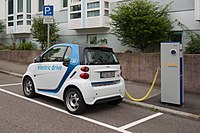Tesla Semi
| Tesla Semi | |
|---|---|
 Tesla Semi | |
| Overview | |
| Manufacturer | Tesla, Inc. |
| Production | 2022–present |
| Assembly | United States: Storey County, Nevada (Gigafactory Nevada) |
| Designer | Franz von Holzhausen[1] |
| Body and chassis | |
| Class | Class 8 heavy-duty truck |
| Body style | Tractor unit for semi-trailer |
| Powertrain | |
| Propulsion | Electric motors |
| Battery | ~900 kWh, 1000 V[2] |
| Electric range | up to 500 mi (800 km) |
| Plug-in charging | 1 MW DC[2] |
The Tesla Semi is a battery electric Class 8 semi-truck built by Tesla, Inc. since 2022. The truck is powered by three motors, and is claimed by Tesla to have approximately three times the power of a typical diesel semi truck, a range of 500 miles (800 km), and operate at an energy use of less than 2 kWh/mi (1.2 kW⋅h/km).[3]
Two concept vehicles were unveiled in November 2017. Tesla CEO Elon Musk originally promised that production would begin in 2019,[4] with Tesla projecting manufacture of as many as 100,000 trucks per year by 2022.[5] Production began in October 2022, several years behind schedule,[6] and initial deliveries were made to PepsiCo on December 1, 2022.[7]
History
The Semi was first mentioned in the Tesla 2016 Master Plan.[8] Tesla said at the time that they had a working prototype that used "a bunch" of Tesla Model 3 electric motors.[9][10][11]
A concept prototype of the Semi was unveiled at a press conference on November 16, 2017, where Elon Musk provided additional specifics. He claimed that the electric Semi would cost 20 ¢/mi (12 ¢/km) less to operate than a diesel truck if charged at a Megacharger, which Tesla said in 2017 they could guarantee a price of 7 ¢/kWh (in the United States).[12][13]

Tesla indicated that the Semi would be equipped with Enhanced Autopilot as standard equipment, offering semi-autonomous capability,[14] and that new technology with active safety controls on the independent motors and wheels would detect and prevent jackknifing.[13] Musk said that the system could eventually allow several units to operate in an autopilot-based convoy, led by a truck with a driver, that would be a cheaper alternative to rail transport.[15] At the time, platooning was legal in only eight U.S. states and all required a human driver in each truck, so changes in legislation would be necessary to achieve that technology capability.[15] The battery packs would be located under the floor of the cab, between the front and driving wheels.[16] Running empty, the long-range Tesla Semi was expected to have a range of 620 miles (997 km).[17] In 2017, Tesla projected that the price of production versions for the 300-mile (480 km) and 500-mile (800 km) range versions would be US$150,000 and US$180,000 respectively. The company stated they would offer a Founder's Series Semi at US$200,000.[18][needs update] At the Semi and Roadster unveiling event, Musk stated "Production [of the semi] begins in 2019, so if you order now, you get the truck in 2 years." Tesla intends to warrant the drivetrain for 1 million miles.[19]
In 2018, Tesla announced that Semi prototypes were being tested with real cargo, hauling battery packs from Nevada to California.[20][21][22]
Company plans to put the semi into production were substantially delayed. At the 2017 unveiling, production was slated to begin in 2019.[19] In June 2019, Tesla projected that production would start by the end of 2020.[23] In January 2020, Musk stated that a lack of battery production capability was one limiting factor for the conservative Semi production timeline, with the company choosing to use battery supply for passenger cars instead.[24][25] In January 2021, the company announced that Semi production would be delayed until the end of 2021,[26][27] as the company hoped to ramp up high-volume production of its tabless 4680 battery cells[28] (previewed in September 2020) to meet the demand for the Semi and other vehicles. In October 2021, Musk announced that the production of the Semi would not start in 2021 and that it could slip into 2023.[29][30][31]
In October 2022, Musk announced on Twitter the start of production of the 500-mile (800 km) range model that would be delivered in December.[32]
In November 2022, the company reported that a Tesla Semi had completed a 500 miles (800 km) drive while weighing 81,000 lb (37,000 kg).[33][34]
On December 1, 2022, Tesla began customer deliveries at an evening event hosted at the manufacturing facility in Nevada. PepsiCo received the first Semis of their large order for use with Pepsi beverage and Frito-Lay snack food transportation fleets.[7] PepsiCo Vice President Mike O'Connell stated that the Semis can haul Frito-Lay food products for around 425 miles (684 km), but for heavier loads of sodas, the trucks will do shorter trips of around 100 miles (160 km).[35]
Before and since the delivery to PepsiCo, several Tesla Semis have been reportedly seen on the side of the road receiving road assistance, raising questions as to their reliability.[36][4]
In late 2023, Tesla announced plans to establish a charging network for the Semi in the southwestern US. The network is expected to cost as much as $100M.[37]
Design
Tesla Semi is powered by three carbon-fiber wrapped motors, offering three times the power of typical diesel semi trucks, although it consumes only 1.7 kWh/mi (1.1 kW⋅h/km). One motor operates continuously at optimal efficiency, while the other two motors provide additional power for acceleration and hills.[3] The Semi's aerodynamic design is inspired by the Japanese bullet trains.[38]
The driver's seat is centered in the cab. The ceiling allows an adult to stand up. Touchscreen displays are set on both sides of the steering wheel, with no other instrument panels.[39][needs update]
It includes the same camera set as Tesla's passenger vehicles. Tesla claims that its safety system can prevent jackknifing.[13][better source needed]
Tesla Semi has a 1,000 volt powertrain and charging system, an increase from Tesla's standard 400 volt system, but a capability Tesla also intends to extend to the Cybertruck.[3] Charging will be supported at a new generation of Tesla vehicle charging infrastructure called the Tesla Megacharger.
The Semi's turning radius is comparable to that of Model Y and Model 3, according to Tesla.[38]
See also
- Megawatt Charging System – Direct current (DC) charging system for large battery electric vehicles
References
- ^ "Early sketch of Tesla Semi truck shared by Chief Designer Franz von Holzhausen". Teslarati. 2017-12-08. Retrieved 2022-12-09.
- ^ a b Kane, Mark (2022-12-04). "Tesla Launches 1,000-Volt Powertrain: Semi Is First But Not The Last". Inside EVs. US. Retrieved 2022-12-30.
- ^ a b c Subramanian, Pras (2022-12-02). "Tesla Semi unveiled with tri-motor setup, megawatt charging tech". Yahoo! Finance. Retrieved 2022-12-05.
- ^ a b Beckford, Andrew (2022-10-21). "Long-Delayed Tesla Semi Truck Seemingly Breaks Down, Causing Highway Delays". Motor Trend. Motor Trend Group. Retrieved 2023-02-25.
- ^ Lambert, Fred (2018-02-08). "Tesla Semi aims to manufacture 100,000 electric trucks per year, say Elon Musk". Electrek. Retrieved 2022-12-07.
- ^ Montanez, Abby (2022-10-07). "Tesla Will Deliver Its First Hotly Anticipated Semi Trucks to PepsiCo This December". Robb Report. Penske Media Corporation. Retrieved 2024-01-06.
- ^ a b Tarantola, A. (2022-12-01). "Tesla finally delivers its first production Semi". Engadget. Retrieved 2022-12-02.
- ^ Bhuiyan, Johana (2016-07-20). "Elon Musk's Master Plan: Solar power, Tesla trucks, self-driving cars and car-sharing". Recode. Retrieved 2022-12-07.
- ^ Lambert, Fred (2017-05-03). "Tesla Semi is using 'a bunch' of Model 3 electric motors, says Elon Musk". Electrek. Retrieved 2022-12-07.
- ^ Lambert, Fred (2017-04-13). "Tesla Semi all-electric truck to be unveiled in September and be "next level", says Elon Musk". Electrek. Retrieved 2022-12-07.
- ^ Lambert, Fred (2017-11-26). "Tesla's VP of Trucks talks about new electric semi, weight, charging, and more". Electrek. Retrieved 2022-12-07.
- ^ Holley, Peter (2017-11-17). "Tesla's latest creation: An electric big rig that can travel up to 500 miles on a single charge". The Washington Post. Retrieved 2022-12-07.
- ^ a b c Harris, Mark (2017-11-20). "More Logical Than Ludicrous: Tesla Semi Will Need to Deliver Reliability". Car and Driver. Retrieved 2022-12-07.
- ^ Estrada, Zac (2017-11-16). "This is the Tesla Semi truck". The Verge.
- ^ a b Lien, Russ Mitchell, Tracey. "Tesla's Semi and Roadster impress, but "production hell" raises doubts about follow-through". Los Angeles Times. Retrieved 2017-11-25.
{{cite news}}: CS1 maint: multiple names: authors list (link) - ^ Davies, Alex (2017-11-16). "Elon Musk Has Unveiled Tesla's All-Electric Semitruck". Wired.
- ^ Drouglazet, Klervi (2017-11-17). "Tesla Semi : ce qu'il faut savoir sur le camion électrique semi-autonome de Tesla" [Tesla Semi: What you need to know]. L'Usine nouvelle (in French). Retrieved 2018-09-18.
Il a une autonomie de 997 km à vide et de 804 km à charge maximum : 40 tonnes de marchandises.
- ^ Tung, Liam (2017-11-24). "Tesla's all-electric Semi truck: Prices start at $150,000 and you can reserve one today". ZDNet. Retrieved 2022-12-07.
- ^ a b Tesla Semi & Roadster Unveil. Tesla. 2017-12-14. Retrieved 2022-12-07 – via YouTube.
- ^ Fingas, Jon (2018-08-27). "Tesla's Semi truck is traveling cross-country 'alone'". MSN. Archived from the original on 2018-08-27. Retrieved 2018-08-27.
- ^ Lambert, Fred (2018-08-25). "Tesla Semi made it 'across the country alone' with only Supercharger network and an extension cord, says Elon Musk". Electrek. Retrieved 2018-08-27.
- ^ Fingas, Jon (2018-08-27). "Tesla's Semi truck is traveling cross-country 'alone'". Engadget. Retrieved 2018-08-27.
- ^ Lambert, Fred (2019-06-11). "Elon Musk updates Tesla pickup and semi truck timelines". Electrek. Retrieved 2022-01-03.
- ^ Motley Fool Transcribers (2020-01-29). "Tesla, Inc. (TSLA) Q4 2019 Earnings Call Transcript". NASDAQ. Retrieved 2020-02-09.
- ^ Kolodny, Lora (2020-01-30). "Elon Musk says Tesla won't raise capital, will focus on lowering cost of batteries". CNBC. Retrieved 2020-02-09.
- ^ Kolodny, Lora (2021-01-28). "Tesla Semi production on hold until company can make its own batteries". CNBC. Retrieved 2021-03-04.
- ^ Lambert, Fred (2021-01-28). "Tesla Semi is ready for production, but they need the 4680 cells, says Elon Musk". Electrek. Retrieved 2021-03-04.
- ^ Field, Kyle (2020-09-22). "Everything You Need To Know About Tesla's New 4680 Battery Cell". CleanTechnica. Retrieved 2021-03-04.
- ^ "2021 Shareholder Meeting". Tesla, Inc. 2021-10-07. Retrieved 2021-10-10.
- ^ Shahan, Zachary (2021-10-08). "Tesla Cybertruck Delayed Till End Of 2022, Semi 2023 – Lot Of Supply Chain Challenges". CleanTechnica. Retrieved 2022-01-03.
- ^ Lockridge, Deborah (2021-10-11). "Tesla Semi in 2023?". Heavy Duty Trucking. Retrieved 2022-01-03.
- ^ McFarland, Matt (2022-10-07). "Tesla set to deliver long-delayed electric trucks to Pepsi in December". CNN Business.
- ^ Mulach, Jordan (2022-11-29). "Tesla Semi reportedly completes 800km range test, US deliveries to begin within days". Drive. Retrieved 2022-11-29.
- ^ Sriram, Akash (2022-12-02). "Musk delivers first Tesla truck, but no update on output, pricing". Reuters. Retrieved 2022-12-02.
- ^ "PepsiCo is using 36 Tesla Semis in its fleet and is upgrading facilities for more in 2023, exec says". CNBC. US. 2022-12-16. Retrieved 2022-12-30.
- ^ Agatie, Cristian (2023-02-03). "Tesla Semis Spend More Time Receiving Assistance Than Hauling Goods". autoevolution. Retrieved 2023-02-25.
- ^ "Report: Tesla seeks $100M from US for Semi charging route". 2023-08-02.
- ^ a b Levin, Tim (2023-10-03). "Jay Leno towed 30 tons with a Tesla Semi and said it felt like nothing". Business Insider.
- ^ O'Dell, John (2017-11-17). "Elon Musk Unveils Superfast, 500-mile Range Tesla Electric Semi-Truck". Trucks.com. Retrieved 2017-11-17.
He provided no pricing information or specifics as to horsepower or torque figures.
External links
- Official website

- Numbers starting to add up for Tesla trucks: DHL executive, president at DHL Supply Chain comments, Reuters, February 23, 2018
- Tesla Semi orders list; 646 as of July 29, 2019


